History of the South Fork Baptist Church Part I
Three buildings, one church, and the cemetery - from 1841 to present
Three Buildings - One Church
By Bobbi Spiker-Conley
For as long as I can remember, our families met at the South Fork Baptist Church in Doddridge county every “Decoration Day” weekend. As kids, we’d attend Sunday School downstairs then return to the sanctuary with the adults for the morning service. After a “good preachin’” and some “song singin’,” everyone would head out to the cemetery to “visit the graves.”
This annual routine, my father explained, was familiar to several generations of our family. Sure, I knew Daddy had grown up in the church. And yes, he was old (cough, cough.) The stained glass pane over the front doors read “1909.” That was a long time ago. Even before Daddy was born! But generations??? That had to mean there was much more to the story of this tiny church than what I had thought.
As I came to find out, the church officially organized in 1841. And from that date to the present, there have always been descendants of the Zinn family numbered among the active members! They gathered at various locations over the years, but there were three buildings titled “South Fork Baptist Church.” That is according to The South Fork Baptist Church - A History - August 1979, written by Mildred Wilson Rule. What follows are notes taken from her transcriptions of the church’s records and additional notes from Brad Spiker. (Links to both writings are provided under Sources below.
Church Organized
- November 1841 - South Fork Church was organized.
- Three of the 15 Charter Members were the son and daughters of our 3rd great-grandparents, John W. and Ruth (Gandy) Zinn.
- From organization to date, there have always been descendants of the family numbered among the active members!
Church Building #1
-
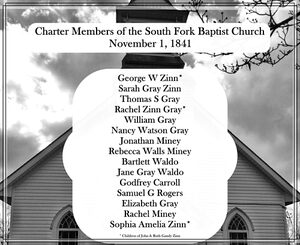 The first church building was a log cabin built near the present location of the Oxford Baptist Church.
The first church building was a log cabin built near the present location of the Oxford Baptist Church. - First seats were split rails with pegs driven in them for legs. They were later changed for plank seats.
- The room was heated by one iron stove.
- The Civil War years saw factions develop, so in the fall of 1861 the church dismissed their pastor and disbanded, not meeting again in the church building until the summer of 1864.
- During that period, some members held services in the Ridge School House, a log building approximately three miles southeast of the original church building.
- From 1864-1868 the church held most of its meetings in the original church building during the summer months and in the Ridge School House during the winter months.
- After the summer of 1868, the church did not return to the church building but continued to meet in the Ridge School House for about four years.
- In March 1870, a committee was appointed to consider building a new church house at a new location.
- On December 7, 1872, the church voted “to move her place of worship to the school house on Lower Run below B.L. Wilson’s,” for several months until the new church building was completed in 1873.
Church Building #2
-
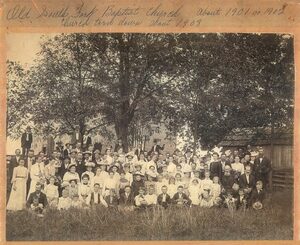 The committee made arrangements to have lumber sawed at the old mill at Holbrook, and secured Andrew Yaler and the Yaler Brothers to build it with the help of the church members and friends of the church.
The committee made arrangements to have lumber sawed at the old mill at Holbrook, and secured Andrew Yaler and the Yaler Brothers to build it with the help of the church members and friends of the church. - The first meeting held in the new building was on September 28, 1873.
- The church house was a large frame construction, 30 x 40 feet, build on a half-acre lot that was deeded to the church by S.V. and Sarah E. Brown in 1871.
Cemetery
- The South Fork Cemetery was established in 1889 on a half-acre lot adjoining the church property.
- The deed was not secured until 1891, but the land offered by Sister Brown came into immediate use for its intended purpose.
-
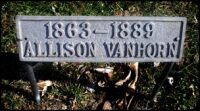 Homer Wilson told that, at the age of 16, he helped dig the first grave in the cemetery - that of his cousin, Allison VanHorn. He planted a cedar shrub to mark the grave, and there it remained for 70 years. In 1959, it was cut down and replaced with a small bronze plate.
Homer Wilson told that, at the age of 16, he helped dig the first grave in the cemetery - that of his cousin, Allison VanHorn. He planted a cedar shrub to mark the grave, and there it remained for 70 years. In 1959, it was cut down and replaced with a small bronze plate. - There are dates of death on several tombstones which pre-date the cemetery’s establishment in 1889; those bodies were moved here from other burial places.
- An iron fence was built around the cemetery in 1904 at a cost of $250. Over the years, that fence has been repaired and was eventually replaced. However, still remaining from the original fence is the arch over the entrance bearing the name, South Fork Cemetery (written 1979.)
-
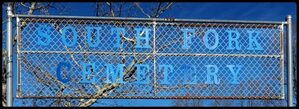 In 1929, a triangular plot of land on the southeastern side of the cemetery was acquired from Homer Wilson, who then owned the Brown Farm.
In 1929, a triangular plot of land on the southeastern side of the cemetery was acquired from Homer Wilson, who then owned the Brown Farm. - In 1960, an additional plot at the northeastern side was obtained from Homer Wilson’s estate.
- When the present place of worship was built in 1909, the old church building was torn down and the lot on which it had stood was taken into the cemetery.
Church Building #3
-
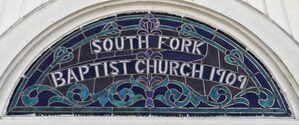 The present church building was erected in 1909 and dedicated June 26, 1910.
The present church building was erected in 1909 and dedicated June 26, 1910. - It was built across the gravel road from the previous structure on land purchased from Mr. & Mrs. R.A. McClain and Mr. & Mrs. J.A. Summers in 1871 for $25.
- The total cost of the structure was $2275, all of which had been collected before the dedication except $316.77, which was raised at that service.
- The dedicatory sermon was presented by Rev. Marshall A. Summers (the first minister ordained at South Fork - 1885) and the dedicatory prayer was by C. Ernest Wilson (the second ordained - 1904.)
- A 1920 newspaper article said this about the dedication: “The crowd attending the dedication was estimated at from 1500 to 2000 people…The church is a beautiful one…with twelve elegant memorial windows with cathedral glass, all placed by friends in memory of departed ones, most of whom were for years members of the Old South Fork Church…One of the best bells in the country is on the church and can be heard for miles around.”
- The first wedding to be held in the church sanctuary was on Thursday, November 20, 1950. Janice Zinn, daughter of Enid and Earl Zinn, and David Dale Ball, son of Sylvia and Toy Ball, were united in marriage.
Notes from Minutes
- 1855 - Member agrees to furnish fuel for the church house for one year for $10
- 1856 - On motion we appoint G.G. Griffin to furnish candles and keep the meeting house lighted.
- 1877 - On motion to buy 1 dozen cheap hymn books for use in the church.
-
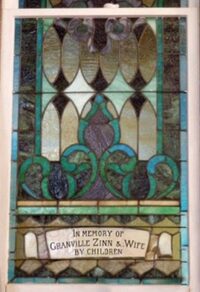 1891 - On motion that the church arranges to buy an organ.
1891 - On motion that the church arranges to buy an organ. - 1915 - A new roof was put on the church building at a cost of $77.17
- 1916 - The side walls of the church were re-papered. The paper cost $7
- 1920 - A gas line was laid to the church building and gas stoves installed.
- 1922 - The cement platform at the front of the church building was constructed. This includes a monument to “the horse and buggy days” in the form of a block of cement rising above the level of the platform at one corner for the convenience of horseback riders in mounting and dismounting.
- 1931 - The president of the Women’s Mission Circle presents a piano to the church.
- 1946 - On motion the moderator appoint a committee to look after securing electricity for the church and the material for the wiring.
- 1946 - The building was wired for electricity.
- 1955 - The papered sidewalls were covered with Celotex paneling.
- 1956 - Plans were made for a cinder block addition, 28 x 32 feet, to be added to the back part of the church building. This room was to serve as Sunday School rooms, kitchen, and dining room. The estimated cost for materials was $1450. Clyde Gray was the carpenter and planned the room.
- 1962 - The gas stoves were replaced by floor furnaces.
- 1963 - The ceiling of the sanctuary was refinished with Celotex replacing the embossed metal ceiling (which had deteriorated) used when the church was built in 1909.
- 1964 - A water system was installed and rest rooms were furnished in the cinder block addition.
- 1979 - A gas forced air furnace was installed.
Sources:
- The Good-Will Community, a History of Holbrook, W.Va. 1814-1945 by Bradford Spiker
- The South Fork Baptist Church - A History by Millie Wilson Rule
- Image of the “church building #2” is from the Enid Wilson Zinn Collection (submitted for our use by Nancy Allman.)
- The first photo in the album below was taken by Haley Cloughessy in May 2015. All other photos of the church and cemeteries were taken by drone pilot, Rando Wilfong in December 2017. Click on any image to view full-size.
From the Enid Wilson Zinn Collection - The Old South Fork Baptist Church circa 1901.
The “2nd church building” was located where the cemetery is now (across the gravel road from the present church.)
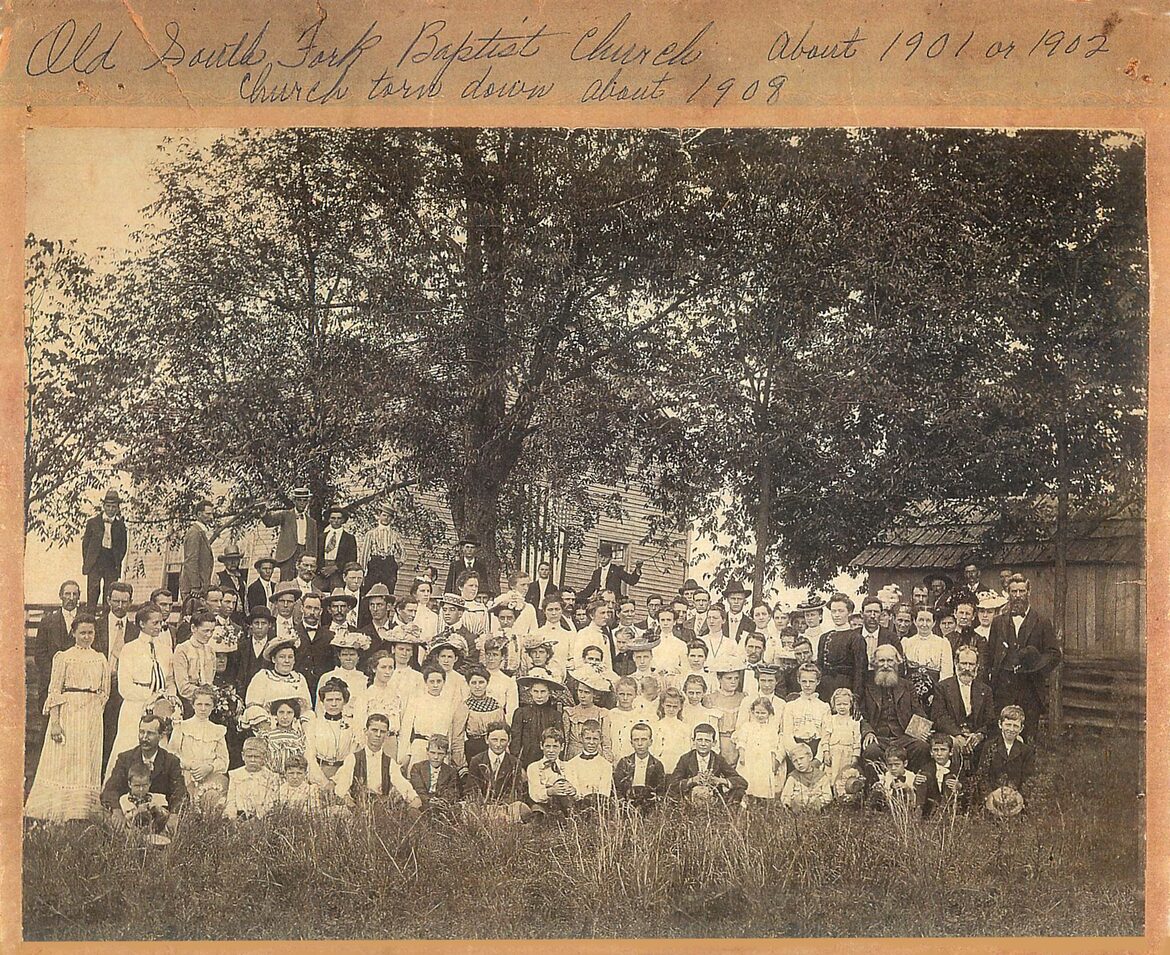
If you can help us positively identify any of those pictured, please contact Bobbi Spiker Conley. Simply refer to the Row Number and Row Color, then the person’s Position in that row, from left to right. For example, Row 2/Blue/Position 17 is George Granville Griffin (1828-1909.)
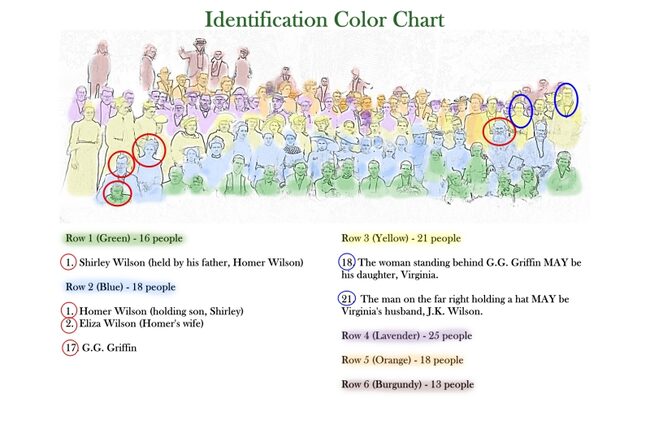
Announcements
-
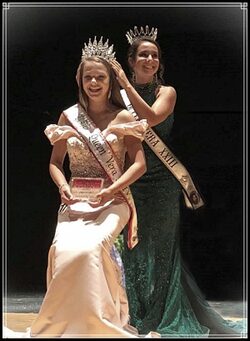 Submitted by Jane Hayes – I am just humbled and could not be more proud of my girls! Tonight [Aug 26] Cali Hayes Queen Vera XXIII crowned her successor, Carigan Hayes as Queen Vera XXIV! What a special moment to watch your daughter crown her sister.
Submitted by Jane Hayes – I am just humbled and could not be more proud of my girls! Tonight [Aug 26] Cali Hayes Queen Vera XXIII crowned her successor, Carigan Hayes as Queen Vera XXIV! What a special moment to watch your daughter crown her sister. -
Submitted by Alison Spiker – Grant, Zelia, and I are moving from our home in Pennsylvania to Ohio at the end of August. Our old address was 138 Maple St., Danville, PA 17821. Our new address is 7002 Wethersfield Place, Worthington, OH 43085. The move is bittersweet. We love Danville but are excited to move to Columbus for Grant’s fellowship - Peds Gastroenterology at Nationwide Children’s. It’s only 2.5 hours from Columbus to Riply. If anyone visits Columbus for shopping or otherwise, we would love to see family!
-
Submitted by Bobbi Spiker Conley – Visit the South Fork Baptist Church - Oxford, WV on Facebook.
-
Submitted by Bobbi Spiker Conley – We’ve edited the March 2018 publication to add a new photo of Aunt Tensie Fay (Zinn) Allman’s home. The original pic was from about 1905; the new pic was taken almost 110 years later.
-
Submitted by Bobbi Spiker Conley – Part II of the History of the South Fork Baptist Church will feature the stained glass memorial windows.